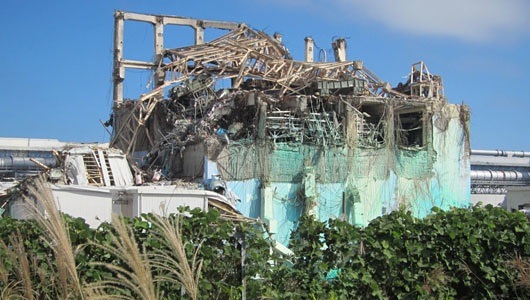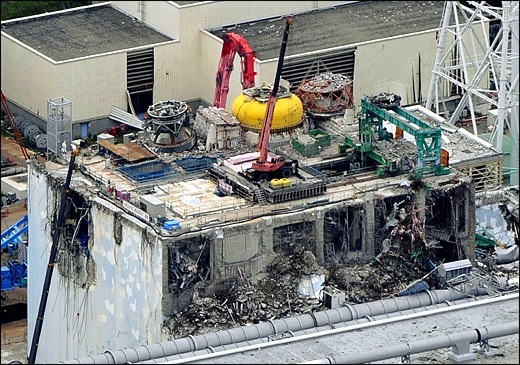SOURCE: Brad Parsons (mauibrad@hotmail.com)
SUBHEAD: Tepco Press Conference - The situation at Fukushima is bleak — “This discharge is beyond our control”
By Kim Hyunbin on 6 August 2013 for Arirang News -
(http://www.arirang.co.kr/News/News_View.asp?nseq=149925)

Image above: The reactor building of Unit 3 is seen at the Fukushima six months after disaster. From (http://www.mnn.com/earth-matters/energy/stories/japan-to-shape-post-fukushima-energy-options-by-spring).
Japan's tsunami-crippled Fukushima nuclear power plant is facing yet another emergency as highly radioactive groundwater appears to have risen above an underground barrier meant to contain it.
The head of the country's Nuclear Regulatory Authority task force Shinji Kinjo told Reuters on Monday that the leak was an emergency, but he was worried the plant's operator, TEPCO, had no sense of how to deal with it.
He went on to say the highly radioactive groundwater is likely seeping into the sea.
In a recent news conference, TEPCO General manager Masayuki Ono said the situation was bleak.
"We understand that this discharge is beyond our control and we do not think the current situation is good."
To prevent further leaks, plant workers are injecting chemicals to create an underground barrier to block groundwater from leaking out to the ocean.
But experts say the barrier may not be enough as it needs certain conditions to solidify.
A retired nuclear engineer who worked on several TEPCO nuclear plants says the company is out of its depth.
"The situation is already beyond what TEPCO can handle. They are doing everything they can but there are no perfect solutions."
Some Japanese media outlets have predicted the contaminated water could breach the ground surface in the matter of just a few weeks.
Just last week, TEPCO estimated a cumulative 20 to 40 trillion becquerels of radioactive tritium may have leaked into the sea since the nuclear disaster some two-and-a-half years ago.
Two Rods Removed from Reactor Four
By Yuri Kagigama on 18 July 2013 for Komo News -
(http://www.komonews.com/news/national/2-fuel-rods-removed-from-wrecked-Fukushima-nuclear-plant-162868926.html)

Image above: Reactor Unit Four with dangerous spent fuel pool in weakened.
A giant crane removed two rods packed with nuclear fuel from the Fukushima nuclear plant on Wednesday, the beginning of a delicate and long process to reduce the risk of more radiation escaping from the disaster-struck plant.
All of the 1,535 rods in a spent-fuel pool next to reactor No. 4 at the Fukushima Dai-ichi plant in northeastern Japan must eventually be moved to safer storage - an effort expected to take until the end of next year, according to the government.
The building containing the pool and reactor was destroyed by an explosion following the failure of cooling systems after a massive earthquake and tsunami in March 2011. The cores of three reactors melted.
Fears run deep about the large amounts of radioactive material stored in the pool, which unlike fuel in the cores of the reactors is not protected by thick containment vessels. The plant's operator, Tokyo Electric Power Co., intends to remove all the rods to eliminate the risk of the pool spewing radiation.
Separately, a reactor at the Ohi nuclear plant in central Japan went online Wednesday, the second to restart after the disasters. Another Ohi reactor was restarted earlier this month.
Tens of thousands of people took to the streets Monday demanding an end to nuclear power, outraged by the restarts. It was the biggest rally since the Fukushima crisis began.
Also Wednesday, the government ordered two utilities, Kansai Electric Power Co., which operates Ohi, and Hokuriki Electric Power Co. to restudy earthquake faults that lie beneath their nuclear plants.
Japanese TV reports showed cranes removing the 4-meter (13-foot) rods. TEPCO declined comment, citing the need for secrecy in handling nuclear material.
About 150,000 people fled their homes after last year's nuclear disaster, the worst since Chernobyl. A 20-kilometer (12-mile) zone around the plant remains a no-go area.
According to a worst-case scenario prepared by the government, a loss of coolant in the spent-fuel pool at reactor No. 4 could have caused a massive release of radiation and forced millions of people to flee.
A year and a half after the disaster, the pool's cooling system has been fixed and reinforcements have been built to prop it up. But TEPCO recently said the wall of the building is bulging, although the pool has not tilted.
Hiroshi Tasaka, a nuclear engineer and professor at Tama University who served as adviser to the prime minister after the disaster, said the spent-fuel pool poses a danger because the building is not sufficiently secure to stop radiation escaping in the case of a strong aftershock.
The two rods removed Wednesday are among 204 that have not been used to generate power and are not as prone to releasing radiation as the 1,331 spent-fuel rods also sitting in the pool.
Tasaka said the government target of removing all the rods by the end of next year may prove too optimistic because of many unknowns, the need to develop new technology and the risk of aftershocks.
"If we are asked whether things are completely safe, we cannot say that," he said. "If there is another major earthquake, we don't know what may happen, although we hope for the best."
.
SUBHEAD: Tepco Press Conference - The situation at Fukushima is bleak — “This discharge is beyond our control”
By Kim Hyunbin on 6 August 2013 for Arirang News -
(http://www.arirang.co.kr/News/News_View.asp?nseq=149925)

Image above: The reactor building of Unit 3 is seen at the Fukushima six months after disaster. From (http://www.mnn.com/earth-matters/energy/stories/japan-to-shape-post-fukushima-energy-options-by-spring).
Japan's tsunami-crippled Fukushima nuclear power plant is facing yet another emergency as highly radioactive groundwater appears to have risen above an underground barrier meant to contain it.
The head of the country's Nuclear Regulatory Authority task force Shinji Kinjo told Reuters on Monday that the leak was an emergency, but he was worried the plant's operator, TEPCO, had no sense of how to deal with it.
He went on to say the highly radioactive groundwater is likely seeping into the sea.
In a recent news conference, TEPCO General manager Masayuki Ono said the situation was bleak.
"We understand that this discharge is beyond our control and we do not think the current situation is good."
To prevent further leaks, plant workers are injecting chemicals to create an underground barrier to block groundwater from leaking out to the ocean.
But experts say the barrier may not be enough as it needs certain conditions to solidify.
A retired nuclear engineer who worked on several TEPCO nuclear plants says the company is out of its depth.
"The situation is already beyond what TEPCO can handle. They are doing everything they can but there are no perfect solutions."
Some Japanese media outlets have predicted the contaminated water could breach the ground surface in the matter of just a few weeks.
Just last week, TEPCO estimated a cumulative 20 to 40 trillion becquerels of radioactive tritium may have leaked into the sea since the nuclear disaster some two-and-a-half years ago.
Two Rods Removed from Reactor Four
By Yuri Kagigama on 18 July 2013 for Komo News -
(http://www.komonews.com/news/national/2-fuel-rods-removed-from-wrecked-Fukushima-nuclear-plant-162868926.html)

Image above: Reactor Unit Four with dangerous spent fuel pool in weakened.
A giant crane removed two rods packed with nuclear fuel from the Fukushima nuclear plant on Wednesday, the beginning of a delicate and long process to reduce the risk of more radiation escaping from the disaster-struck plant.
All of the 1,535 rods in a spent-fuel pool next to reactor No. 4 at the Fukushima Dai-ichi plant in northeastern Japan must eventually be moved to safer storage - an effort expected to take until the end of next year, according to the government.
The building containing the pool and reactor was destroyed by an explosion following the failure of cooling systems after a massive earthquake and tsunami in March 2011. The cores of three reactors melted.
Fears run deep about the large amounts of radioactive material stored in the pool, which unlike fuel in the cores of the reactors is not protected by thick containment vessels. The plant's operator, Tokyo Electric Power Co., intends to remove all the rods to eliminate the risk of the pool spewing radiation.
Separately, a reactor at the Ohi nuclear plant in central Japan went online Wednesday, the second to restart after the disasters. Another Ohi reactor was restarted earlier this month.
Tens of thousands of people took to the streets Monday demanding an end to nuclear power, outraged by the restarts. It was the biggest rally since the Fukushima crisis began.
Also Wednesday, the government ordered two utilities, Kansai Electric Power Co., which operates Ohi, and Hokuriki Electric Power Co. to restudy earthquake faults that lie beneath their nuclear plants.
Japanese TV reports showed cranes removing the 4-meter (13-foot) rods. TEPCO declined comment, citing the need for secrecy in handling nuclear material.
About 150,000 people fled their homes after last year's nuclear disaster, the worst since Chernobyl. A 20-kilometer (12-mile) zone around the plant remains a no-go area.
According to a worst-case scenario prepared by the government, a loss of coolant in the spent-fuel pool at reactor No. 4 could have caused a massive release of radiation and forced millions of people to flee.
A year and a half after the disaster, the pool's cooling system has been fixed and reinforcements have been built to prop it up. But TEPCO recently said the wall of the building is bulging, although the pool has not tilted.
Hiroshi Tasaka, a nuclear engineer and professor at Tama University who served as adviser to the prime minister after the disaster, said the spent-fuel pool poses a danger because the building is not sufficiently secure to stop radiation escaping in the case of a strong aftershock.
The two rods removed Wednesday are among 204 that have not been used to generate power and are not as prone to releasing radiation as the 1,331 spent-fuel rods also sitting in the pool.
Tasaka said the government target of removing all the rods by the end of next year may prove too optimistic because of many unknowns, the need to develop new technology and the risk of aftershocks.
"If we are asked whether things are completely safe, we cannot say that," he said. "If there is another major earthquake, we don't know what may happen, although we hope for the best."
.
No comments :
Post a Comment